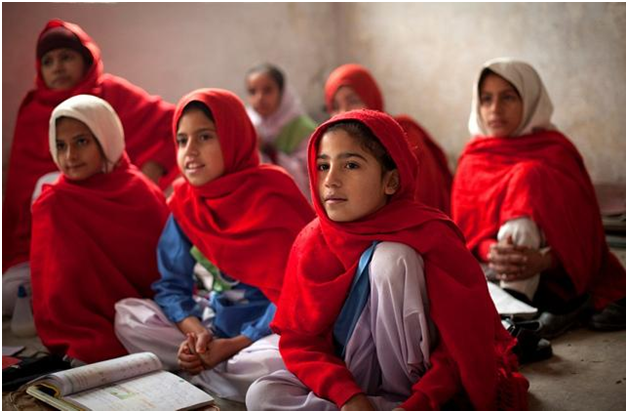Rage, Rage Against the Dying of Light
Young girls in a school in Pakistan
Ghalib’s lines echo in my mind when I was in Lahore earlier
“Hairan hoon dil ko ro’oon ke peetoon jigar ko mein
Maqdoor ho tau saath rakhoon nauha gar ko mein”
(Should I cry out my heart or lament my soul
If I could I would keep by my side a professional mourner)
Violence against women makes my heart lurch each time I open the newspaper.
Wherever I turn I am accosted with stories of women harmed, I use the word deliberately. It is a calibrated harm, a dismembering that goes on. Five, ten dozen stories leap at me everyday. The day I arrived, the gruesome stoning to death of a 26 year old pregnant Farzana Parveen in front of the Lahore high court was breaking news. In three days it had already receded to inside pages. There was a lot of noise made by various actors. Prime Minister Nawaz Sharif ordered an inquiry, CJ ordered the police to file time bound report, National and State Women’s Commissions demanded action, and human rights organizations issued statements. Where will all this concern end? How often has such public outrage erupted and what has it yielded?
On 16 December 2012 India was convulsed with the gang rape and subsequent death of Nirbhaya a young pharmacy student. The day I left Delhi for Lahore there was another convulsion, this time in UP. It was caused by the gang rape and hanging of two little dalit girls from an eponymous village Shahadat Ganj in Badaun. The statement of the CM of UP was reported in the press. He was responding to a reporter who asked him about rapes in his state. He said ‘You haven’t been harmed, have you? No-- right? Great, thank you’. This comment was carried by Dawn here. The unfortunate remark made a few weeks ago during the election campaign by the Samajwadi Chief Mulayam Singh that rapists should not receive death penalty ‘boys will be boys’ has also been featured in Pakistan press in the context of the Shahadat Ganj rapes.
I returned to India to once again confront our own traumas pertaining to gender based violence. Meanwhile in Pakistan the scenario is as gruesome. In one day, in three metros, Lahore, Karachi, Rawalpindi, three women’s stories have hit big time news. These are three that have been projected in media but there are dozens of others which have been summed up in one- liners in back columns. One can only imagine scores of incidents from remote areas of FATA and Khyber-Pakhtunkhwa which remain unreported.
The three stories are the following. Hold your sensibilities as I recount the bare outline. In Lahore South Cantonment a man (Ghulam Rasool of Vehari) cut off the legs of his wife, mother of five children, on suspicion of infidelity. In Rawalpindi a thirty year old Rubina Naeem, a mother of two girls was found hanging while her two Rida, nine and Maimoona, six year old girls were shot through their heads. The police started by reporting a case of murder-suicide by the dead woman. When the Rubina’s mother accused her daughter’s bigamous husband Malik Pervez alias Malik Naeem, who had been torturing her daughter and revealed that she had lodged a police complaint in the very same thana a few months back the story took another turn. The third site of crime was Karachi where a woman and her two children were strangled to death by her relatives for the crime of marrying against their wishes. In this case, however, the husband too was shot dead when he returned late night from duty.
In Nawa e Waqt, the Urdu newspaper that I read everyday there is a daily column called Ziyadtiyan, meaning excesses. It contains one-line news about sexually used and abused women, girls and children. Its tiny print makes impossible reading. But it is there for any one who takes pain to read and compile the data.
In Pakistan Assembly there are 60 women MNA’s who are often in the news for their stands on various issues. In India the new Cabinet has 7 women Ministers besides 61 women elected to the 16th Lok Sabha. The Prime Minister of India dedicated himself to the dignity of ‘mothers and daughters in his very first speech on May 19 2014. There is need now in both countries to translate intentions into action because in both Pakistan and India undervaluation of women has become a cancer that is going to kill the body politic. As India’s Planning Commission we tried to bring women to the top of the development agenda. In Pakistan institutions like National Commission on Status of Women and Human Rights Commission of Pakistan have been struggling to do the same since their inception in 2000 and 1987 (respectively). But these are still bare branches; the flower and fruit is not visible.
Although like Ghalib I am the archetypal mourner for gender but I know this is not the answer. I pull myself out of this depression and like Dylan Thomas ‘Rage rage against the dying of the light’. Meanwhile women are being sacrificed daily in the shahadat ganj’s (sacrifice areas) on both sides of the border.





